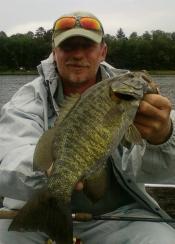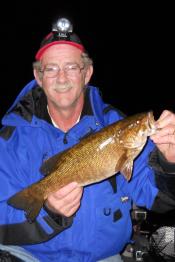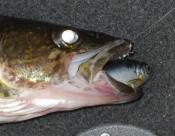 I had my annual marathon fishing trip this last week in the Boulder Junction, WI area where I try to fish for as many hours a day as I can. Normally, I schedule this for early June, but with the circumstances of including multiple families, we had to accept the dates that would work. Though I chase multiple species throughout the week, I had a primary goal and a few new products I wanted to test.
I had my annual marathon fishing trip this last week in the Boulder Junction, WI area where I try to fish for as many hours a day as I can. Normally, I schedule this for early June, but with the circumstances of including multiple families, we had to accept the dates that would work. Though I chase multiple species throughout the week, I had a primary goal and a few new products I wanted to test.
Utilizing information from Bob Bowman, Jeremy Liebig, and a few other IDO’rs I wanted to apply a much stronger influence of the moon phases (majors and minors) to weather patterns (highs & lows ) along with other general factors to see how much of a difference they really made. What I learned is how much of the puzzle I wasn’t t looking at prior when predicting fish should be active. After this week of fishing for hours before, during, and after these peak times – I am a firm believer of using this information to your advantage.
Crappies –(stained color lakes) In our “off” time, table fare was relative easy to find along patches of cabbage weeds. Targeting 6 to 12 fow, we tossed small white beetle spins. A key factor was very short casts. The crappies were hanging in about the middle of the water column and preferred hitting on the fall. Much like pitching for bass, we pitched our beetle spins to the holes in the cabbage weeds. By sunset, the crappies were actively chasing minnows and a steady retrieve just beneath the surface produced very well.
On the clear bodies of water we found the crappies to be suspended over deeper water. In most cases we marked fish 8 to 16 feet down in 20+ feet of water. I have to admit that I felt like it was cheating on this trip. When we marked a large school of suspended panfish, I dropped the Marcum 625 camera head down to take a quick peek at what I was marking. There are no words to describe how much time this saved. Ironically small schools of suspended perch or bass were giving very similar returns on the locator as the crappies. Drifting with 1” white twister tails or the small beetle spins with a 3/8 oz split shot did good. We managed to put a couple meals of nice crappie fillets in the freezer for each of us.
 Walleyes and Smallies – The irregular spring and weather patterns this year has definitely put a twist on the when/where aspect of locating fish. Many reports of no May flies or other substantial hatches have taken place on many of the lakes. We found both the walleyes and smallmouth in a state of transition between healthy weeds and deep rock bars. Early in the week, dissecting the weed beds with a 3/16 oz jig and ring worm produced very well. In hind sight, we all found the best action for numbers came about 20 minutes into the minor of the solunar table we had. The spurts of increased activity would last 15 to 30 minutes, and then it was back to a fish here and there. Also noticed was the intensity of the strikes. Pitching ringworms in the weeds for summer walleyes is generally a reaction strike. You drop it right in front of their nose, and they pop it. We found during the minor and the major times, the fish often were suspended in the column and hit with a purpose.
Walleyes and Smallies – The irregular spring and weather patterns this year has definitely put a twist on the when/where aspect of locating fish. Many reports of no May flies or other substantial hatches have taken place on many of the lakes. We found both the walleyes and smallmouth in a state of transition between healthy weeds and deep rock bars. Early in the week, dissecting the weed beds with a 3/16 oz jig and ring worm produced very well. In hind sight, we all found the best action for numbers came about 20 minutes into the minor of the solunar table we had. The spurts of increased activity would last 15 to 30 minutes, and then it was back to a fish here and there. Also noticed was the intensity of the strikes. Pitching ringworms in the weeds for summer walleyes is generally a reaction strike. You drop it right in front of their nose, and they pop it. We found during the minor and the major times, the fish often were suspended in the column and hit with a purpose.
Each day produced much less in the weeds and the activity on the deeper humps and rock bars steadily increased. This was true for both the smallies and walleyes as we found them together everywhere we fished. By our 4th day, we concentrated 100% of our efforts on the deeper water ranging 14 to 26 fow. With low pressure over us and a mass of high pressure moving in it was relatively easy to adjust our presentations. During the low pressure times, combined with the peak of the major/minor, it was all crankbaits. At the peak of the frenzies, it really didn’t matter what you threw. But in the off times, we saw fish settling back near the bottom of the water column and not raising much to hit a crank passing by. This where a couple of new products I wanted to test really paid off. Using a Quantum 7’ med./fast with 15# Cajun Braid, I made a steady rotation of different cranks Vs the line up of the Koppers Live Target cranks. Using both the Koppers’ lip-less and lipped far out produced similar products by Rapala, Berkley, and others. Like you, I’m a consumer and have a hard time opening my wallet for spendy crankbaits. But, after dropping $600.00 on gas, lodging, food…. I want to go catching and these baits paid dividends!
A major highlight of the week was meeting up again with Mark Benson. This was a real treat for me to tag along in his boat this time. (Especially after fishing 16 to 18 hours a day and becoming a fishing zombie) But we picked up right where we left off last year and left a lot of fish with S.J.S. (Sore-Jaw-Syndrome) Mark quickly dialed in on their preference for a half crawler on a CJS jig, while I experimented with a couple things. Leech on a float was a pain, and was put to rest very fast. Deep diving crank was thumped with no connection. Vertical jigging a Live Target Gizzard Shad made quick order of keeping up with Mark’s crawler. By 3:00am, we had a couple nice eyes in the live well, released countless 14” to 17” eyes, and had a phenomenal frenzy of smallies.
Thanks Mark for the outing! Your care package will be on its way!
 Musky – I spent the least amount of time chasing musky. I’ve had a couple encounters with a few monsters over the last couple years snatching walleyes from me. So I hit an area that was common to see some big fish. Only about 5 or 6 casts gave me a memory that will last a lifetime. Unfortunately, I failed to seal the deal on the hookset…..Over 16fow between a cabbage bed and a deep rock bar, it looked as if the US Navy launched a nuke and all heck had erupted. As quickly as it happened, it plays over and over in slow motion in my mind. About a 50” class musky hammered a Poe’s Awaker, went airborne, tested my grip on the rod, and with a head shake – said good-bye. So much for the fish of a thousand casts…..But we managed a few small skies for the very limited amount of time we invested – 24”, 28”, and a 38”. All were on light tackle and the release was much more important than the photo opt.
Musky – I spent the least amount of time chasing musky. I’ve had a couple encounters with a few monsters over the last couple years snatching walleyes from me. So I hit an area that was common to see some big fish. Only about 5 or 6 casts gave me a memory that will last a lifetime. Unfortunately, I failed to seal the deal on the hookset…..Over 16fow between a cabbage bed and a deep rock bar, it looked as if the US Navy launched a nuke and all heck had erupted. As quickly as it happened, it plays over and over in slow motion in my mind. About a 50” class musky hammered a Poe’s Awaker, went airborne, tested my grip on the rod, and with a head shake – said good-bye. So much for the fish of a thousand casts…..But we managed a few small skies for the very limited amount of time we invested – 24”, 28”, and a 38”. All were on light tackle and the release was much more important than the photo opt.
 So as the summer patterns continue, I urge you to take some time to learn more about the major / minor solunar tables. I am still reading and learning all I can. The most important lesson I have learned and wanted to share is the timing and influence this has in the worst of conditions. Just briefly – I was out during the first evening/night of a high pressure mass that settled in with a bright full moon. I was marking fish deep all around a rock bar with almost nothing to show for my efforts. Listed minor was 9:21pm to 10:21pm and the major was 1:52am to 3:52am. Around 9:30 I began marking a few fish moving shallower from 20 fow to 14 fow. I was casting cranks and think I was fishing too fast. I proceeded to catch a couple walleyes and a few more bass. By just after 10:00, these fish had all moved back to deep water. I ground out a couple fish until well after 1:00am. Just like flipping a switch, I began marking fish on top of the rock bar that topped out at 8 fow. I had a great frenzy of action, though the bite was soft. All the eyes I caught were barely hooked by the last treble hook, and all the bass were hooked in a similar way. Naturally, I also missed a number of fish. But the point is that using this information of timing kept me motivated on the water until the next prime time. Even though the bite was soft, I still had steady activity and a lot of fun. It doesn’t mean that they will always be on fire, just giving you a better chance.
So as the summer patterns continue, I urge you to take some time to learn more about the major / minor solunar tables. I am still reading and learning all I can. The most important lesson I have learned and wanted to share is the timing and influence this has in the worst of conditions. Just briefly – I was out during the first evening/night of a high pressure mass that settled in with a bright full moon. I was marking fish deep all around a rock bar with almost nothing to show for my efforts. Listed minor was 9:21pm to 10:21pm and the major was 1:52am to 3:52am. Around 9:30 I began marking a few fish moving shallower from 20 fow to 14 fow. I was casting cranks and think I was fishing too fast. I proceeded to catch a couple walleyes and a few more bass. By just after 10:00, these fish had all moved back to deep water. I ground out a couple fish until well after 1:00am. Just like flipping a switch, I began marking fish on top of the rock bar that topped out at 8 fow. I had a great frenzy of action, though the bite was soft. All the eyes I caught were barely hooked by the last treble hook, and all the bass were hooked in a similar way. Naturally, I also missed a number of fish. But the point is that using this information of timing kept me motivated on the water until the next prime time. Even though the bite was soft, I still had steady activity and a lot of fun. It doesn’t mean that they will always be on fire, just giving you a better chance.
Sorry if this became a long read. I just felt there was a lot of worthy information to share, and a lot of information gained from so many hours on the water this week. Best luck to all!
Here’s a few other highlights from the trip.
Nice fish & pics
Sounds like a good time.

I got to get up there and meet Mark sometime myself
Randy,
Nice read and good info. Way to go on the homework and making it work on the water.
Jack
Nice fish guys
Nice job Randy!!
Boys, Randy’s eyes were tired!!! Randy mentioned I was dialed in on ’em and frankly the night before we were supposed to get together to try the same thing on one of two lakes closer to him. As it turned out, my business needed a little attention after hours for a sale, so I was unable to make it and fortunately Randy had family to keep him entertained…
I need to run, but will be back to finish my account and post a couple of pics…
Mark
Excellent report Randy. Many anglers (including myself) say they don’t care about solunar tables because “they fish when they can”. However, your report certainly demonstrates the differences in fishing tactics that one can apply while on the water and how those fish are relating to the minor and major solunar changes.
Many anglers (including myself) say they don’t care about solunar tables because “they fish when they can”. However, your report certainly demonstrates the differences in fishing tactics that one can apply while on the water and how those fish are relating to the minor and major solunar changes. 
X2 – Loved the background on the bite Randy. Thanks for sharing your knowledge!
Joel
Spot on Randy, awesome report